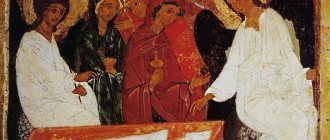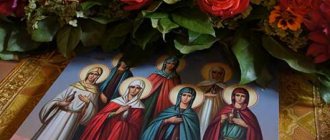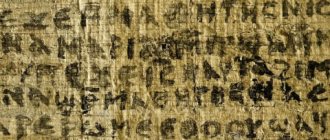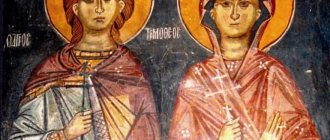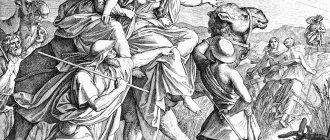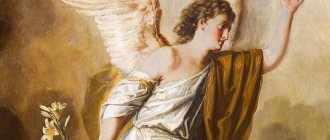The third week after Easter is the Feast of the Myrrh-Bearing Women. In the Gospel they are not all named - after listing several names, the evangelists add: “and others.” Unfortunately, even by those named, it is impossible to fully understand which specific person we are talking about.
The evangelists speak of Mary Magdalene, Mary of Cleopas, Salome and John as those who came to the tomb of the Savior. Church Tradition also refers to Susanna, Martha and Mary as the Myrrh-Bearing Women.
We have collected some (and even contradictory) information about these holy women.
01
Mary Magdalene
Maria was from the city of Magdala. She is the first person in the world to whom the risen Savior appeared. She was ordered to tell the apostles about this greatest event. According to legend, after the Ascension of Christ, Mary Magdalene preached in Rome and met with Emperor Tiberius, to whom, as a sign of the truth of the Resurrection of Christ, she presented a chicken egg that turned red in his hands - from this began the pious tradition of painting eggs at Easter and consecrating them along with other offerings . She is revered by the Church as an Equal-to-the-Apostles saint.
03
Lives of the Myrrh-Bearing Women
The Church presents the generally accepted lives of seven important women in Orthodoxy:
- Mary Magdalene
. Before she met Christ, the woman led a sinful life, because of which seven demons settled in her. When the Savior expelled them, Mary repented and followed him, serving Him and the holy apostles. Based on the large number of references to this myrrh-bearing wife, we can conclude that she stood out among others for her faith and devotion. - Joanna
. Many holy myrrh-bearing women came to the Son of God after he performed some miracle, so Joanna followed Christ when he healed her dying son. Before this, she was a rich woman who did not follow the commandments of the Lord. - Salome
. According to church traditions, she was the daughter of the holy righteous Joseph the Betrothed. She gave birth to the apostles James and John. - Maria Kleopova
. It is believed that this woman is the mother of the Apostle James Alpheus and the Evangelist Matthew. - Susanna
. When figuring out who the myrrh-bearing women are, it is worth noting that not a lot of information is known about all women, for example, Susanna is mentioned once in a passage by the Apostle Luke, in which he talks about how Jesus traveled through cities to preach. Susanna was one of the wives who accompanied him. There is no other information about her. - Martha and Mary
. These are sisters who also had a brother - Saint Lazarus the Four-Days. They believed in Christ even before his resurrection. The Church believes that Mary was the woman who poured a pound of pure precious ointment on the head of Jesus, thereby preparing his body for burial.
Martha and Mary
Sisters of the righteous Lazarus, whom the Savior resurrected. Traditionally they are counted among the Myrrh-Bearing Wives, although their names are not mentioned in the Gospel among the wives who came to the tomb of Christ. They are also described in the Gospel (Luke 10:38–42) as people with different characters: during the Savior’s home sermon, Mary sat at His feet and listened, and Martha was busy with housework. According to legend, after the Ascension of Christ, the sisters and Lazarus moved to Cyprus, where they helped their brother carry out his episcopal service.
04
Myrrh-Bearing Women - who are they?
The women who were the first after Saturday to come to the Tomb of Jesus Christ, who was resurrected, bringing him aromas and incense (myrrh) for the ritual anointing of the body are the myrrh-bearing women. The seven women spoken of in various scriptures were faithful to Jesus Christ to the end, and they did not run away like the disciples and apostles, leaving the Son of God to die on the Cross. Finding out who they are, the myrrh-bearing women, it is worth saying that they were not afraid to turn to Pontius Pilate so that he would allow him to take the body of Jesus for burial.
According to existing legends, early in the morning of the third day, the women came to the burial place with a prepared world. They were not afraid of guards and arrest, and therefore were rewarded by being the first to learn and see the Resurrection of Christ. At first, the myrrh-bearing women did not believe what had happened, since Jesus was resurrected in another body, but when they heard his voice, they were convinced of the miracle. The story explaining what the myrrh-bearing women means is instructive in many ways. The main conclusion is that a loving heart is ready for much and even to overcome fear and death.
Myrrh-Bearing Women - names
In fact, the evangelists call different women’s names, but as a result of the analysis carried out by specialists and, taking into account the Holy Tradition, seven real persons can be identified. If you are interested in the names of the myrrh-bearing women, then remember the following names: Mary Magdalene, Mary of Cleopas, Salome, Joanna, Mary, Martha and Susanna. Each woman had her own unique life story, but they were brought together by a great love for the Lord God. There is no reliable information about other myrrh-bearing wives.
Angel Mary Day according to the church calendar
Angel Mary Day is celebrated several times a year throughout the year according to the church calendar. On this day, you must definitely visit the temple and read a prayer in front of the face of the saint named Mary.
Dates for celebrating the day of the angel Mary according to the church calendar:
| date | Patron Saint |
| January 31 | Maria of Radonezh, schema-nun |
| February 8 | Mary of Constantinople, Palestine, Venerable |
| 2nd of March | Mariamne (Mary) |
| 20th of March | Maria Grosheva, nun, martyr |
| 14th of April | Mary of Egypt, Venerable |
| 25th of April | Maria Vifanskaya |
| May 17 | Mary Magdalene, Equal to the Apostles (myrrh-bearer) |
| June 5 | Maria Cleopas, Jacob, Josiah (myrrh-bearer) |
| June 11 | Maria Ustyuzhskaya |
| June 20 | Mary of Caesarea (Palestinian), martyr |
| July 2 | Mary, mother of Joseph |
| July 17th | Maria Romanova, Grand Duchess, Passion-Bearer |
| August 4 | Mary Magdalene, Equal to the Apostles (myrrh-bearer) |
| August 28 | Blessed Virgin Mary, Mother of God |
| 8 September | Maria Diveevskaya (Fedina), Fool for Christ's sake |
| September 21 | Blessed Virgin Mary, Mother of God |
| October 11 | Maria of Radonezh, schema-nun |
| 11th of November | Maria Khidanskaya, reverend |
| December 15 | Maria Zhuravleva, venerable martyr |
Saint Mary in Orthodoxy
In the Orthodox tradition, the doctrine of virginity is accepted.
Maria is a name of Hebrew origin (Mariam), translated as “beloved”, “desired”. In the Christian tradition, the meaning of the name is different - “lady”. This is due to the fact that this name was borne by the mother of Jesus Christ.
The Orthodox tradition has accepted the doctrine of virginity. According to this doctrine, the Virgin Mary “conceived a virgin, gave birth to a virgin, remained a virgin.” Hymns to the Mother of God are an integral part of worship in the Eastern Church and their positioning within the liturgical sequence indicates the position of the Mother of God after Christ. In the Orthodox tradition, the order of listing the saints begins with the Mother of God, followed by angels, prophets, apostles, church fathers, martyrs, etc.
The prerequisites for the exaltation of the Virgin Mary by all peoples (clans) are given in the Bible itself. John the Theologian in the Gospel of John testifies that Jesus performed the first miracle at the request of his mother, therefore the Mother of God is revered as an intercessor for the human race. There are a huge number of icons of the Mother of God. Many of them are considered miraculous.
There are various Christian views on the role of the Virgin Mary in Christianity, from complete veneration of Mary in the Roman Catholic Church to a minimized role of Mary in Protestant evangelical theology.
The Nativity of the Blessed Virgin Mary is a holiday dedicated to the birth of the Blessed Virgin Mary. The Nativity of the Virgin Mary is celebrated on September 21.
The Entry into the Temple of the Blessed Virgin Mary is a holiday dedicated to one of the events in the life of the Virgin Mary. The holiday is celebrated on December 4th.
The Orthodox holiday of the Dormition of the Virgin Mary is celebrated on the day of the death of the Virgin Mary. The Dormition of the Virgin Mary is celebrated on August 28.
The Protection of the Blessed Virgin Mary is celebrated on October 14. It is believed that the Mother of God saved Constantinople.
Joanna
She was the wife of Chuza, one of the officials at the court of the ruler of Galilee, Herod Antipas. Joanna occupied a very high position and had great influence and connections. During the days of Christ’s preaching, it was Joanna who took upon herself the lion’s share of the expenses of the apostolic community, taking care of food and everything necessary for the Lord and His disciples. There is a version that such generosity of such a noble lady is not accidental - according to a number of interpreters, the son of a courtier, healed by Christ (John 4: 46 - 54), was the child of Joanna, and the grateful woman after that served the Savior with everything she could.
The story of the head of John the Baptist is connected with her name. As you know, for his denunciations against Herod, the Forerunner was first arrested and then beheaded at the libel of Herodias, Herod’s concubine. After the wicked woman violated the head of the prophet she hated, she threw her “trophy” into a landfill. Joanna, seeing all this and deeply grieving over the death of the Forerunner, secretly dug up the head at night, put it in an earthenware vessel and buried it on the Mount of Olives, in one of Herod’s estates.
Myrrh-Bearing Women in the Modern World
Orthodoxy glorifies completely different qualities of women, for example, devotion, sacrifice, love, faith, and so on. Many have chosen a different path for themselves, focusing on other values, for example, fame, money, indifference, but there are exceptions. You can find many stories about how modern myrrh-bearing women glorify the Lord and live a righteous life. This includes nurses, volunteers, mothers of many children, whose love is enough not only for their children, but also for everyone in need, and other women who live for the benefit of others.
Myrrh-Bearing Women - Orthodoxy
According to church canons, the day dedicated to holy women is analogous to March 8. The Week of the Myrrh-Bearing Women begins after Easter on the third week; it is worth pointing out that the word “week” means Sunday. On this holiday, women in ancient times always took communion, and then cheerful celebrations were held. The Holy Fathers say about myrrh-bearing wives that every woman on Earth is awarded such a title, since she brings peace to her family, gives birth to children and is the keeper of the hearth.
On the 3rd Sunday after Easter, the Holy Church remembers the holy myrrh-bearing women and the righteous Joseph of Arimathea and Nicodemus - the secret disciples of Christ. This day among Orthodox people has truly always been considered a day on which the feat of a believing Orthodox woman is glorified. The Day of the Holy Myrrh-Bearing Women is an Orthodox women's day. This holiday has been especially revered in Rus' since ancient times. The main feature of Russian righteousness is the special, purely Russian type, chastity of Christian marriage as a great Sacrament. Every woman on Earth is a myrrh-bearer in life - she brings peace to the world, her family, her home, she gives birth to children, and is a support to her husband. Orthodoxy exalts the woman-mother, the woman of all classes and nationalities. Therefore, the Week (Sunday) of the Myrrh-Bearing Women is a holiday for every Orthodox Christian, Orthodox Women's Day.
Icon “The Appearance of Christ to the Myrrh-Bearing Women”
Myrrh-Bearing Women at the Holy Sepulcher. 15th century icon. Russian Museum.
Who are they, the holy myrrh-bearing women - Mary Magdalene, Mary of Cleopas, Salome, Joanna, Martha, Mary, Susanna, and why does the Russian Orthodox Church honor their memory on the second Sunday after Easter?
The myrrh-bearers
are the same women who, out of love for the Savior, received Him in their homes, and later followed Him to the place of crucifixion on Golgotha. They were witnesses of Christ's suffering on the cross. It was they who hurried in the dark to the Holy Sepulcher to anoint the body of Christ with myrrh, as was the custom of the Jews. It was they, the myrrh-bearing women, who were the first to know that Christ had risen. Jesus appeared to Mary Magdalene and asked the apostles to wait for Him in Galilee.
Saint Mary of Clopas
Saint Mary of Cleopas, the myrrh-bearer, according to the tradition of the Church, was the daughter of Righteous Joseph, the Betrothed of the Blessed Virgin Mary (December 26), from her first marriage and was still very young when the Most Holy Virgin Mary was betrothed to Righteous Joseph and introduced into his house. The Holy Virgin Mary lived with the daughter of Righteous Joseph, and they became friends like sisters. Righteous Joseph, upon returning with the Savior and the Mother of God from Egypt to Nazareth, married his daughter to his younger brother Cleopas, therefore she is called Mary Cleopas, that is, the wife of Cleopas. The blessed fruit of that marriage was the holy martyr Simeon, an apostle from the age of 70, a relative of the Lord, the second bishop of the Church of Jerusalem (April 27). The memory of Saint Mary of Cleopas is also celebrated on the 3rd Sunday after Easter, the holy myrrh-bearing women.
Saint Joan the Myrrh-Bearer
Saint Joan the Myrrh-Bearer, the wife of Chuza, the steward of King Herod, was one of the wives who followed the Lord Jesus Christ during His preaching and served Him. Together with other wives, after the Savior's death on the Cross, Saint Joan came to the Tomb to anoint the Holy Body of the Lord with myrrh, and heard from the Angels the joyful news of His glorious Resurrection. Memory: July 10
Righteous sisters Martha and Mary
The righteous sisters Martha and Mary, who believed in Christ even before His resurrection of their brother Lazarus, after the murder of the holy Archdeacon Stephen, the onset of persecution against the Church of Jerusalem and the expulsion of the righteous Lazarus from Jerusalem, helped their holy brother in preaching the Gospel in different countries. No information has been preserved about the time and place of their peaceful death. The holy myrrh-bearing women show us an example of true sacrificial love and selfless service to the Lord. When everyone left Him, they were nearby, not afraid of possible persecution. It is no coincidence that the Risen Christ was the first to appear to Mary Magdalene. Subsequently, according to legend, Holy Equal-to-the-Apostles Mary Magdalene worked hard in preaching the Gospel. It was she who presented the Roman Emperor Tiberius with a red egg with the words? “Christ is Risen!”, hence the custom of painting eggs at Easter. The Holy Orthodox Church celebrates this day as a holiday for all Christian women, celebrates their special and important role in the family and society, strengthens them in their selfless feat of love and service to their neighbors.
Mary Magdalene
Mary Magdalene (Hebrew: מרים המגדלית, ancient Greek: Μαρία ἡ Μαγδαληνή, lat. Maria Magdalena) - wife of Jesus Christ, Christian saint, myrrh-bearer, who, according to the Gospel text, followed X rist. The nickname “Magdalene” (Hebrew: מרים המגדלית, ancient Greek: Μαρία ἡ Μαγδαληνή), which this one of the Gospel Marys bore, is traditionally deciphered as “a native of the city of Migdal-El.” The literal meaning of this toponym is “tower” (Hebrew migdal and Aramaic magdala), and since the tower is a feudal, knightly symbol, in the Middle Ages this noble connotation of meaning was transferred to the personality of Mary and she was given aristocratic features . It has also been suggested that the nickname "Magdalene" may be derived from the Talmud's expression magadella (Hebrew: מגדלא), meaning “hair-curler.” The character referred to as “Miriam who curls the hair of women” (Hebrew: מרים מגדלא שער נשייא) appears in a number of Talmudic texts related to Jesus, one of which refers to her as an adulteress. It is possible that these texts reflected stories about Mary Magdalene. Among medieval writers unfamiliar with Hebrew and Ancient Greek, the etymologies are most often fantastic: “Magdalene” can be interpreted as “constantly accused” (Latin manens rea), etc. The name Mary Magdalene, Magdalene, later became popular in Europe in various forms.
Painting by Perugino, c. 1500
In the Orthodox and Catholic churches, the veneration of Magdalene is different: Orthodoxy venerates her exclusively as the myrrh-bearer, cured of seven demons and appearing only in a few Gospel episodes, and in the tradition of the Catholic Church for a long time it was customary to identify with her the image of the repentant harlot and Mary of Bethany, as well as attach extensive legendary material. Protestant interpreters also disputed the identity of Mary the Harlot and Mary, Sister Martha of the Gospel Mary Magdalene from the very beginning; Magdalene is revered exclusively as the holy myrrh-bearer.
Veneration in Orthodoxy
In Orthodoxy she is revered as an Equal-to-the-Apostles saint, relying only on the gospel testimonies listed above. Byzantine literature tells how, some time after the Crucifixion, Magdalene went to Ephesus with the Virgin Mary to John the Theologian and helped him in his labors. Of the four evangelists, John provides the most information about Magdalene. It is believed that Mary Magdalene preached the gospel in Rome, as evidenced by the appeal to her in the letter of the Apostle Paul to the Romans (Rom. 16:6). Probably in connection with this journey, an Easter legend associated with her name arose. The Orthodox tradition does not identify Mary Magdalene with the gospel sinner, but venerates her exclusively as the holy myrrh-bearer, equal to the apostles, from whom demons were simply cast out. Thus, Demetrius of Rostov writes in her life: Even if Magdalene were a harlot, then after Christ and His disciples she is clearly a sinner who has been walking for a long time, so that the haters of Christ would speak to the Jews, seeking some kind of guilt against Him, so that they would blaspheme and condemn Him. Even if the disciples of Christ had once seen the Lord talking with the Samaritan woman, marveling, as if speaking to a woman, how much more would the hostile woman not keep silent when they saw a clearly sinner following and serving Him all the days. — Demetrius of Rostov, “Lives of the Saints: July 22” There is no mention of fornication in its akathist. In addition, Orthodoxy did not identify Magdalene with several other evangelical women, which happened in Catholicism; it traditionally honored these women separately. On September 2, 2006, for the first time, the relics of Mary Magdalene and a particle of the Life-Giving Cross arrived in Russia (from the Mount Athos monastery of Simonopetra). In the Cathedral of Christ the Savior, Orthodox shrines were available to believers until September 13, after which they were transported to seven cities of the country.
Carlo Crivelli. "Mary Magdalene", c. 1480, Bonnefantenmuseum, Maastricht. A saint with long flowing hair holds a vessel with incense in her hands
Western European apocryphal legends provide many details, for example, her parents' names were Sir and Eucharia. Much is told about her preaching activities, which, unlike Byzantine stories, are associated not with Asia Minor, but with the territory of France. In particular, as they say, after the Crucifixion, Mary, together with her brother and sister Martha and Saints Maximin, Martel and Cydonius, went to proclaim Christianity in Gaul, in the city of Massilia (Marseille) or at the mouth of the Rhone (Saintes-Marie-de-la- Mer).
“Mary Magdalene”, sculpture by Donatello, 1455, Florence, Duomo Museum. The saint is depicted emaciated, in rags, after many years of hermitage.
The second half of Magdalene’s life, according to these Western legends, went like this: she retired to the desert, where for 30 years she indulged in the strictest asceticism, mourning her sins. Her clothes had decayed, but her shame (nakedness) was covered by long hair. And the emaciated old body was carried to heaven every night by angels to heal it - “God feeds her with heavenly food, and angels lift her to heaven every day, where she listens to the singing of heavenly choirs with her “bodily ears”” (lat. corporeis auribus).
“The Elder Gives the Himation to Mary Magdalene.” Fresco by Giotto in the Magdalene Chapel of the lower Basilica of San Francesco in Assisi, 1320s.
Before her death, Magdalene is given communion by a priest who accidentally wanders into these parts, who is at first embarrassed by the nakedness of the saint covered with hair. Saint Maximin goes to her, spends his last minutes with her (and Mary Magdalene, when meeting Blessed Maximin, prays in the choir of angels, rising above the ground at a distance of two cubits). Then he buries his old comrade in the church he founded. The saint's relics are still displayed in the church in Provence (Saint-Maximin-la-Sainte-Baume) on the Way of Saint James. Unlike the Ascension of the Virgin Mary, the meaning of which is that the Mother of God was taken to heaven bodily after death, the Ascension of Mary Magdalene was simply a form of her interview with the Lord and after death she was not taken bodily to heaven.
“The Ascension of Mary Magdalene”, painting by Jusepe de Ribera, 1636
To understand the composition of the legend, it is important that the plot of Magdalene’s asceticism has many parallels or even possible direct borrowings from the life of St. Mary of Egypt, her namesake and late contemporary, about whom, unlike Magdalene, it is directly testified that she was a harlot. Researchers note that the borrowing may have occurred in the 9th century and the attributes merged with the plot of both saints. That is, the harlot Mary of Egypt is another woman whose image was united with Magdalene and contributed to the perception of her as a sinner. The story about Mary of Egypt formed the basis of the legend “On the Hermit Life” of Mary Magdalene. They also mention the influence of the legend of the harlot St. Taisia of Egypt, a famous courtesan converted by Abbot Paphnutius.
Memory
The death of Mary Magdalene, according to this movement in Christianity, was peaceful: she died in Ephesus. Memory: - July 22/August 4; - in the third week after Easter, called the Week of the Myrrh-Bearing Women. According to the “Four Menaions” of Demetrius of Rostov, in 886, under Emperor Leo VI the Philosopher, the relics of the saint who died in Ephesus were solemnly transferred to the Constantinople monastery of St. Lazarus. The Catholic Church considers the location of the relics of Mary Magdalene to be the Lateran Basilica, where they were placed under the altar consecrated by Pope Honorius III in her honor. Also, the location of the relics since 1280 is considered to be the churches of Sainte-Baum and Sainte-Maximin in Provence, where, in particular, her head is kept. Currently, the relics of Mary Magdalene are known to be found in the following Athonite monasteries: Dochiar, Simonopetra (right hand) and Esphigmen.
Temples dedicated to Mary Magdalene
Church of St Mary Magdalene in Woolwich (South London), UK; Church of St. Mary Magdalene in Dobrowoda, Poland; Church of St. Mary Magdalene in Tarnobrzeg, Poland; Church of the Holy Myrrh-Bearer Mary Magdalene in Avdeevka, Donetsk region, Ukraine; Church of St. Mary Magdalene Equal to the Apostles in Minsk, Belarus; Church of St. Mary Magdalene Equal to the Apostles in Bila Tserkva, Kiev region, Ukraine. The emergence of the tradition of Easter eggs is associated with Mary Magdalene: according to legend, when Mary came to Emperor Tiberius and announced the Resurrection of Christ, the emperor said that it was as impossible as for a chicken egg to be red, and after these words the chicken egg, which he held, blushed. Obviously, the legend dates back to the very late Middle Ages (since it was not included in the extensive collection “Golden Legend” of the 13th-14th centuries). However, according to another version of the presentation, Mary Magdalene gave the emperor an egg painted red (This is how St. Demetrius of Rostov describes this episode).
Marriage of Jesus
A year after the death of Joseph, on October 28, 16, Jesus, fulfilling the oath given to his father, got married. His chosen one was Mary Magdalene. The Bible does not say that Jesus was married. But nowhere is it reported that he was single. Mary Magdalene is mentioned several times in the Gospels. She accompanies Jesus on some of his trips, is often nearby, and after the death of Jesus she is the first to come to his grave, i.e. behaves like a person very close to him, like a wife. Why is there no clear and distinct indication in the Bible that Mary Magdalene is the wife of Jesus? In 325, when the Gospels were rewritten, all evidence indicating that Jesus and John the Baptist were married men was removed. This was done in order to legitimize the vow of celibacy taken by all Christian priests. This order of affairs in the Roman Catholic Church has survived to this day. The centralized church required a huge army of clergy - obedient, faithful, efficient. It is much easier to subjugate a single person to your will than a married person, so for the Church the image of an unmarried Jesus (and John too) was very beneficial. Christian priests, taking a vow of celibacy, sincerely believed that they were acting according to the rules established by Jesus himself. At the same time, women were universally declared sinners, communication with whom could destroy the human soul. Women were to be avoided, communication with them was to be kept to a minimum and, if possible, not even looked in their direction. It was then that the following phrase from the mouth of Jesus was inserted into the Bible (Matthew 5:28): “But I tell you that whoever looks at a woman to lust after her has already committed adultery with her in his heart.” It is impossible to control a person in love and happy, so the Church, disguising its intentions as virtue, tried to suppress all carnal desires in people. After appropriate processing of the Gospels, Mary Magdalene turned from the wife of Jesus Christ into a harlot, and her name even became a common noun to designate girls of a certain profession. In fact, Mary in life was a modest, pure girl who was madly in love with her husband Jesus. Maria in her youth was distinguished by rare beauty - amazing brown eyes, round face, long black hair, slender figure with a thin waist. Jesus was happy in his family life, loved his wife and children - he and Mary had three sons and a daughter. Jesus got married at age 20. According to the customs of that time, the husband was not required to be at home all the time, so Jesus traveled quietly while Mary Magdalene was at home in Nazareth with his mother. Previously, a man did not live with a woman all year round, but only in certain months favorable for conceiving a child. During these months, Mary Magdalene sometimes accompanied Jesus on his travels. Almost all of Jesus' disciples - the apostles - had wives and children. Naturally, there is not a line about this in the Bible; only in one place is it briefly mentioned that the Apostle Peter had a mother-in-law.
Crucifixion of Jesus
Jesus entrusted his beloved disciple John with taking care of his mother long before the events occurred.
During the execution on Calvary, neither the Virgin Mary nor John was present. John, having learned about the exact day of Jesus’ execution, went to Nazareth to fetch Mary, deciding to come with her to Jerusalem on the second day after the execution. He found Mary agitated, she told him that when she lay down to rest yesterday afternoon (Tuesday), she dreamed of Jesus - he called her and asked for help; when she woke up, she felt a terrible pain in her heart, which still has not gone away. John did not say anything, explaining the reason for his coming by saying that Jesus wanted to see her in Jerusalem on Saturday. But is it possible to deceive a truly loving mother’s heart! It already knew the hours when her beloved son suffered incredible torments. Maria immediately felt something was wrong; she could not find a place for herself either on the last day before the journey or on the road, she felt especially bad when there was only half a day left to Jerusalem. How could John, who loved Jesus Christ and the Virgin Mary so much, allow the eyes of this sweet, kind woman to see how the executioners mocked her own son? How can a heart in which there is even a small grain of love and compassion withstand the whole picture of the torment of Jesus? Not to mention a mother's heart. And no matter how holy the Virgin Mary was, she simply could not bear all this, and John understood this perfectly. And the words in the Bible: “...She, in the eyes of everyone, stood fearlessly at the foot of the cross...” could only be written by a person who does not know what it is like to lose a loved one, who does not know the feeling of pain. This could only be written by a person with an icy heart, for whom the feeling of compassion is alien and incomprehensible. The kind of torment that Jesus endured is scary to imagine even after two thousand years, let alone look at it while standing calmly next to it. The heart of any mother could not withstand such grief; it would have broken even before her son was crucified on the cross. We are not talking about the hearts of those mothers who, for the sake of faith, sacrifice their babies, as sectarians do, or because they have nothing to feed their children, or simply do not want to raise them, send them to orphanages, or have an abortion and kill the unborn . The Virgin Mary, who became the Mother of the entire human race, could not and did not see the torment of her Son!!! On Friday, April 20
Joseph of Arimathea
, a very influential man, one of the 72 members of the highest court of Judea, the Sanhedrin, came to Pontius Pilate Joseph turned to Pilate with a request to give him the body of Jesus Christ for honorable burial in his own tomb. For this, Joseph was even ready to pay a large ransom. Pilate had great respect for this man, so he granted his request without taking any ransom. In addition, Pilate was tormented by his conscience because, on his orders, an innocent man, a righteous man, lost his life. Pilate sent a man to the place of execution to find out if Jesus had really died. At this time, two people were near Jesus - John of Zebedee and the elder of the Essenes religious society. This elder asked the centurion, who was in charge of guarding the place of execution, not to break the knees of the deceased Jesus. According to the custom of that time, the knees of the person who died on the cross were torn apart in order to finally make sure of the death of the latter. The elder knew that Jesus was actually still alive. The elder explained to the centurion that the crucified man was indeed a respected person and worthy of an honorable burial; now a large ransom would be paid for him to Pontius Pilate, so there is no point in spoiling the body of the deceased. The centurion allowed Jesus not to break his knees. He even knew that Jesus was still alive, but he did not tell anyone about it. “It was a day of preparation, and on Saturday bodies were not supposed to hang on crosses, and besides, it was a special Easter Saturday. Therefore, the Jews asked Pilate to allow those crucified to have their legs broken and their bodies removed from the crosses. The soldiers came and broke the legs of first one crucified man, then the other. When they approached Jesus, they saw that He was already dead, and they did not break His legs.” Gospel of John. The secret disciples of Jesus, Joseph of Arimathea and Nicodemus, having received permission from Pontius Pilate to release the body, set to work. On Friday at noon, the body of Jesus was transferred to Joseph's tomb, located not far from the place of execution. Joseph and Nicodemus, having swaddled the body of Christ, soaked the bandages with a solution made from medicinal oils and balms. Jesus prepared this solution long before his execution. “Nicodemus brought about thirty kilograms of a mixture of myrrh and aloe. They took down the body of Jesus and wrapped it and the balm in linen cloth. This was the Jewish burial custom." Gospel of John. “Joseph took it, wrapped it in clean linen, and placed it in a tomb he had recently purchased, carved out of the rock.” Gospel of Matthew. All procedures lasted until four o'clock in the evening. Then the body of Jesus, anointed with perfume, carefully swaddled in bandages, was wrapped in a huge white shroud. In the morning, Roman soldiers came to look at the body of Jesus and were convinced that he was indeed buried according to all laws. After all the inspectors were convinced of the death of Jesus, the entrance to the tomb was blocked with a large stone. In the morning, the Jewish priests were simply shocked to learn that Jesus was buried in the personal tomb of Joseph of Arimathea, a member of the very Sanhedrin that condemned Jesus to death. And he was helped by another member of the Sanhedrin - Nicodemus. And the Roman governor Pontius Pilate ordered the body of the executed blasphemer to be handed over for an honorable burial. It seemed to the high priests that there was some kind of conspiracy against them. The priests and Pharisees turned to Pilate with a request: - Master! We remembered that the deceiver, while still alive, said: after three days I will rise again. So, order that the tomb be guarded until the third day, so that his disciples, coming at night, do not steal it and say to the people: he has risen from the dead. Otherwise, the last deception will be worse than the first. Pilate, who was very angry with the priests who had previously threatened to denounce him to Rome, sharply answered them: “If you have guards, go and guard them as best you can.” Caiaphas ordered that guards be placed at the tomb and seals placed on the stone. He did not like the behavior of Pilate, who was too obviously sympathetic to Jesus. It was no longer possible to rely on Roman power - now we had to do everything ourselves. On Sunday morning, April 21, Mary Magdalene, at the teaching of Joseph of Arimathea, without saying a word to anyone, together with her maid Mary, the mother of James and Salome, approached the crypt. Mary Magdalene saw the guards sitting and told them that Jesus had risen and do not look for his body here. Among those guarding the crypt of Jesus was the Apostle Andrew. He sat near the tomb and waited for the resurrection of Christ. I doubted it, but nevertheless, in the depths of my soul I believed that maybe Christ would really rise again. Mary approached him and said what Joseph had taught her: Jesus had risen and told his disciples to wait for him in Galilee. By this, Joseph wanted to deceive the priests and send them on the wrong trail. The main thing is that they do not look for Jesus in Jerusalem. The puzzled and frightened guards opened the crypt. The seals that Caiaphas ordered to be placed on the tomb were intact, that is, no one entered or left the crypt. The opened room turned out to be empty! Only scraps of bandages and a shroud lay on the floor. The guards froze in place, not knowing what to do next. Meanwhile, Mary Magdalene and the women accompanying her went to Peter and John and told them that Jesus had risen. They didn’t believe it and ran headlong to the crypt. John overtook Peter and was the first to look into the tomb, where he found only bandages and a shroud. The apostles went to the other disciples to tell the amazing news. Magdalene remained at the tomb to see what would happen next. The guards sent to Pilate to report that a miracle had happened and Jesus had risen! The found shroud was taken by the women and handed over to the Mother of God. Joseph and Nicodemus reassured Mary, and now she looked forward to meeting her resurrected son. Now this relic is in Italy and is known throughout the world as the Shroud of Turin. The face of Jesus is imprinted on it. Soon there was no crowd near the crypt - soldiers and curious people ran in... It was impossible for Jesus’ disciples to stay in Judea, because they would be severely persecuted. The apostles did as Jesus advised them - they cast lots to determine who would go to which country. Our Lady Mary also took part in the draw, and she got Georgia. But at the last moment Jesus appeared to her and ordered her to go to Gaul (France). Joseph of Arimathea and Nicodemus were preparing to leave Judea and leave forever for distant Gaul. Before leaving, Joseph of Arimathea, Nicodemus, Mary Magdalene and the Mother of God urgently sold all their property - houses and things. All this had to be done in complete secrecy; even Jesus’ disciples knew nothing about the upcoming departure. Forty days after the last meeting, Jesus appeared again to his disciples. He blessed them for their deeds and disappeared into the fog. From the outside it looked like Jesus had ascended to heaven. Our Lady Mary died in 59, having lived 78 years. Mary Magdalene died at the age of 92. They are all buried in one place near each other. Their graves are located on the territory of modern France. The house of the Virgin Mary has not survived to this day.
Equal to the Apostles Mary Magdalene. In the hand there is a vessel for washing the feet - a symbol of humility.
In Christ, the female sex is also at war, included in the army according to spiritual courage and not rejected for bodily weakness.
And many wives were no less distinguished than their husbands: there are those who became even more famous. Such are the virgins who fill the face with themselves, such are the confessions shining with the exploits and the victories of martyrdom. St. Basil the Great The truly chaste, making every effort to take care of the soul, do not refuse to serve the body, as an instrument of the soul, in moderation, but consider it an unworthy and low thing for themselves to adorn the body and be magnified by it, so that by nature it is a slave, did not become proud before the soul to which the right of dominion was entrusted... St. Isidore Pelusiot From the diaries of the holy royal martyr Empress Alexandra Feodorovna of Russia Romanova
Christianity, like heavenly love, elevates the human soul. I am happy: the less hope, the stronger the faith. God knows what's best for us, but we don't. In constant humility I begin to find a source of constant strength. “Daily dying is the path to daily life”... Life is nothing if we do not know Him, thanks to Whom we live. The closer the soul approaches the Divine and Eternal Source of Love, the more fully the obligations of sacred human love are revealed, and the sharper the reproaches of conscience for neglecting the least of them. Love does not grow, does not become great and perfect suddenly and on its own, but requires time and constant care. True faith is manifested in all our behavior. It's like the sap of a living tree that reaches the farthest branches. The basis of a noble character is absolute sincerity. True wisdom does not consist in the assimilation of knowledge, but in the correct application of it for good. Humility is not about talking about your shortcomings, but about enduring others talking about them; in listening to them patiently and even gratefully; in correcting the shortcomings that we are told about; is not to feel hostility towards those who tell us about them. The more humble a person is, the more peace there is in his soul. In all trials, seek patience, not deliverance; if you deserve it, it will come to you soon... Go forward, make mistakes, fall and get up again, just keep going. Religious education is the richest gift that parents can leave to their child; inheritance will never replace this with any wealth. The meaning of life is not to do what you like, but to do what you should do with love. For most of us, the main temptation is the loss of courage, the main test of our strength is in a monotonous series of failures, in an irritating series of prosaic difficulties. It's the distance that wears us down, not the pace. Moving forward, choosing the right path, making your way towards the faintly flickering light and never doubting the supreme value of goodness, even in its smallest manifestations, is the common task of life for many, and by doing it people show what they are worth. Self-sacrifice is a pure, holy, effective virtue that crowns and sanctifies the human soul. In order to climb the great heavenly ladder of love, you yourself must become a stone, a step of this ladder, on which others will step as they climb up. The religion inspired by the word of Christ is sunny and joyful. Joy is the hallmark of a Christian. A Christian should never become discouraged; he should never doubt that good will triumph over evil. A crying, complaining, fearful Christian betrays his God. In countless ways, the word of Christ, sunk into the heart, manifests itself in life. In times of trouble it brings us comfort, in times of weakness it brings us strength. The important work a man can do for Christ is what he can and should do in his own home. Men have their share, it is important and serious, but the true creator of the home is the mother. The way she lives gives the house a special atmosphere. God first comes to the children through her love. As they say: “God, in order to become closer to everyone, created mothers” - a wonderful thought. Mother's love, as it were, embodies the love of God, and it surrounds the child's life with tenderness... There are houses where the lamp is constantly burning brightly, where words of love for Christ are constantly spoken, where children are taught from an early age that God loves them, where they learn to pray, just starting to babble. And, after many years, the memory of these sacred moments will live, illuminating the darkness with a ray of light, inspiring in times of disappointment, revealing the secret of victory in a difficult battle, and the angel of God will help to overcome cruel temptations and not fall into sin. How happy is a home where everyone - children and parents, without a single exception - believes in God together. In such a house there is a joy of camaraderie. Such a house is like the threshold of Heaven. There can never be alienation in it. The Holy Orthodox Church celebrates this day as a holiday for all Christian women, celebrates their special and important role in the family and society, strengthens them in their selfless feat of love and service to their neighbors. How different is this holiday from the so-called International Women's Day on March 8, established by feminist organizations in support of their fight for the so-called women's rights, or rather for the liberation of women from family, from children, from everything that makes up the meaning of life for a woman. Isn’t it time for us to return to the traditions of our people, restore the Orthodox understanding of the role of women in our lives and celebrate the wonderful holiday of the Holy Myrrh-Bearing Women more widely? The new era that has come is associated with the rebirth of women, and it is the woman who has a special role in it. “They will ask: “Why is this age called the Age of the Mother of the World?” Truly, that is what it should be called. A woman will bring great help, not only bringing enlightenment, but also establishing balance. In the midst of confusion, the magnet of balance is disturbed, and free will is needed to connect the disintegrating parts...” (Aboveground, 772). All ancient religions honor the Mother of the World in one aspect or another as female deities and honor Goddesses on an equal basis with Gods. In ancient Egypt it is Isis, Kali among the Hindus, Sophia among the Gnostics, Dukkar in Tibet, Guan Yin in China, Venus in Phenicia, Bellus in Assyria, Anahita in Persia. Also, Zoroaster, the founder of Zoroastrianism, highly valued the Feminine Principle, and His Testaments affirm the greatness of Cosmic love as the basic principle of the existence of the universe. There is no female deity in Buddhism, but Buddha also valued women highly. The path of a woman in the process of human evolution, throughout the entire Kali Yuga, is incredibly difficult and immensely painful, and the lower the general cultural level of the peoples, the more difficult the position of the woman. The position of women in the West was especially difficult in the dark era of the Middle Ages, when the ignorant clergy interpreted a woman as the source of all sin, as an accomplice and helper of Satan, as a sorceress and a witch. The position of women has improved in the Western world since the Renaissance. Although for a long time a woman was a thing that could be bought, sold and exchanged for a horse, a gun or a dog, as the ideas of humanism developed and spread in many countries of the world, a woman, although with great difficulty, was gaining more and more rights. Knowing from her bitter experience how unbearable any violence and injustice is, a woman always protested against any spirit of violence, regardless of to whom it was manifested, she always sympathized with the oppressed and insulted more than a man and developed in herself one of her most valuable and best qualities - compassion and sensitivity to other people's grief and suffering. Lacking the strength and ability to defend herself, the weaker woman, however, often found both the strength and the opportunity to protect her children from a stronger man, if necessary. The Teaching of Life speaks of the need to establish two Principles (male and female), because only in their unity, in their merging, is both cosmic and earthly creativity possible. One Origin cannot be higher and another lower. They can only be equal, complementary to each other. Both feminine and masculine are only different poles of one Whole, and they cannot exist one without the other. Man is approaching the Age of Balance between the male and female Principles. And now the Great Teachers will affirm the woman, therefore the new era will not only be the era of Great Cooperation, but also the era of the woman. It is necessary to call a woman. Cultural leader of humanity, philosopher, artist N.K. Roerich in his article “To a Woman’s Heart” says: “When it is difficult in the house, then they turn to a woman. When calculations and calculations no longer help, when enmity and mutual destruction reach their limits, then they come to a woman. When evil forces prevail, then a woman is called. When the calculating mind turns out to be powerless, then they remember the woman’s heart. Truly, when anger crushes the decision of the mind, only the heart finds saving solutions. Where is the heart that will replace a woman’s heart? Where is the courage of the heart's fire that can be compared with the courage of a woman on the edge of despair? What hand can replace the soothing touch of the persuasiveness of a woman’s heart? And what eye, having absorbed all the pain of suffering, will respond both selflessly and for the Good? We are not praising women. It is not praise that fills the life of mankind from the cradle to rest. “Who was given the wreaths? Since ancient times, wreaths were given to heroes and were the property of women. And the women of ancient times, in fortune-telling, took off these wreaths and threw them into the river, while always thinking not about themselves, but about some other person.” If a wreath-crown is a symbol of heroism, then it is precisely the imprinting of this heroism, precisely when it is removed in the name of something or someone else. And this is not just idle self-sacrifice. No, this is an effective feat! And again it will not be praise, but reality, when we compare a woman with her exploits.” (“Fiery Stronghold”).
Calendar of Orthodox holidays and days of remembrance.
Good Friday. Holy Resurrection of Christ - Easter. Bright Week Radonitsa. Parents' Day Ascension of the Lord Trinity Day. Pentecost Femininity MARCH 8 – International Women's Day
Copyright © 2015 Unconditional love
Myrrh-Bearing Women - prayer
Since great women for the Orthodox Church performed feats in the name of love for the Lord, prayer appeals are offered to them, just like to saints. The prayer to the myrrh-bearing women is a request that holy women ask before the Lord for deliverance from sins and forgiveness. They turn to them to find love for Christ, as they themselves did. Regular prayer requests help soften and tender the heart.
external reference
- Wikimedia Commons has a media category for Maria de Cleophas
. - Maria Kleopova
- Website of the Fraternity of Santa Maria Cleofe - Totana (Murcia)
- The content of this article includes materials from the Popular Illustrated Encyclopedic Dictionary Salvat for the years 1906–1914, which are in the public domain.
| authoritative control |
|
- Data: Q235377
- Multimedia: Maria Klopa
